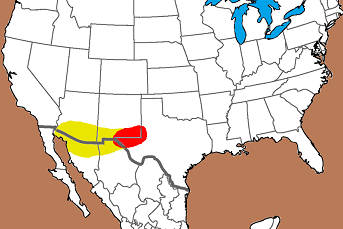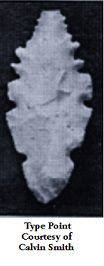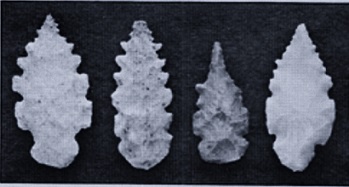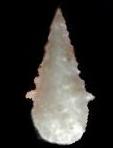Name Details:
Named By: Calvin B. Smith
Named For: Type Site
Date Identified: 1972
Type Site: Maljamar Site, New Mexico
Maljamar
Cluster: Maljamar Cluster
Commonly Utilized Material:
Date:
Cultural Period:
3,000 - 1,900 B.P.
Late to Transitional Archaic
Neoglacial to Medieval Warm
Glacial Period:
Culture:
Outline is Representative of Size and Shape:
Description of Physical Characteristics and Flaking Pattern:
This is a small to medium ( 1
to 2.5 inches) ovoid side notch
point with an elliptical cross section. The blade may vary from straight to excurvate. The blade is heavily serrated and
may be slightly asymmetrical due to serrations. The serrations are commonly evenly spaced notch pairs. The maximum width of the blade is just above the shoulders. Shoulders may
vary from horizontal to having a upward slope. Some examples may have weak or absent shoulders giving the point a more ovoid appearance. The stem is expanded and generally has a narrower width than the blade. The base may vary from convex to pointed. This point has a random flaking pattern.
Size Measurements: Length - 30 to 55mm average 34mm,
Stem Length - average 11 mm, Blade Width - 15 to 23 mm average 17mm,
Neck Width - average 5 mm, Stem Width - average 13 mm,
Thickness - average 6 mm
Distribution:
Distribution Comments:
This point is primarily found in southern New Mexico and into the northern panhandle of Texas (red). This point has been reported at Ventana Cave and Canyon Creek Ruin in Arizona, but
are infrequently found in Arizona (yellow).

Related / Associated Points:
Additional Comments:
The survey near the Jarilla Mountains collected many examples of this type of point, but they were included in the Lerma type (Justice, 2002).
These point were generally made from a bi-pointed to ovoid preform which were notched towards the base. This may give the hafting area a wide variety of appearances (Justice, 2002).
Smith (1972), suggest that this type had it's origins in the Tularosa Basin and was later brought across the mountains into the Maljamar region as a result of
immigration..
Other points in this Cluster:
Point Validity: Valid Type
Smith is a prominent archeologist who has published numerous highly referenced publication
on southwestern archeology. He has serves as Curator of the Blackwater Draw Museum. He currently serves as CEO of the Legacy Museum Consulting firm. This type was named in a professional
publication and has many professional references. This is considered a valid type.
.
Age Details:
Dating on this type is not fully understood. This type represents a pre-ceramic Archaic form that is constant with the late Archaic to transitional Archaic period. Oxygen Hydration on examples from a site east of El Paso provided a date of 502 B.C (Justice, 2002). MacNeish (1993) places this point tentatively in the Hueco Phase (ending approx. 2,200 B.P) of the Chihuahua
tradition, based on work at the Jordan region of New Mexico.
Pictures Provided By:
Calvin B. Smith
References: (See Reference Page, Entry Number):
23, 30, 39, 87, 167
Maljamar Projectile Point, Maljamar Arrowhead




